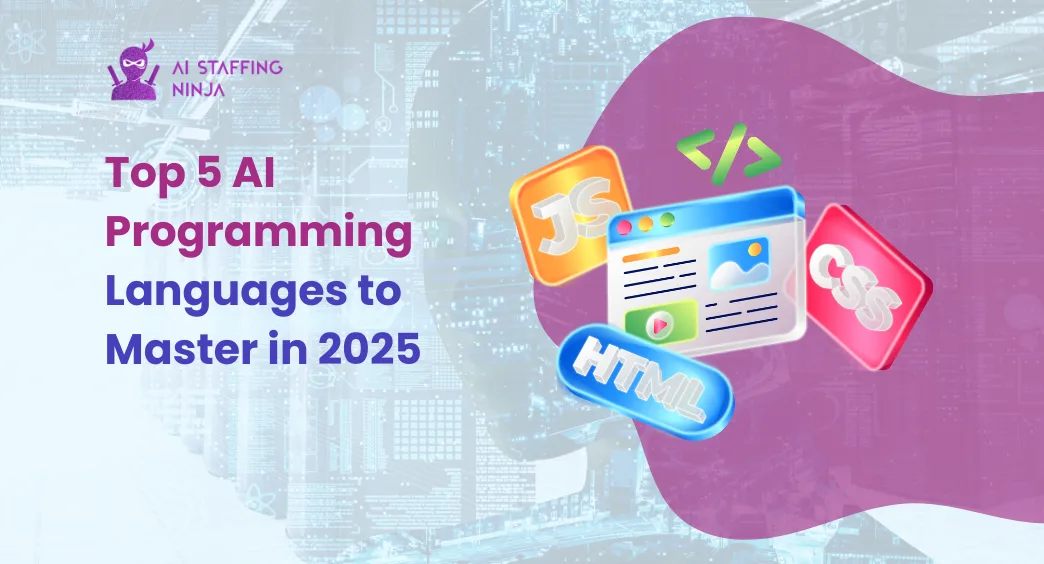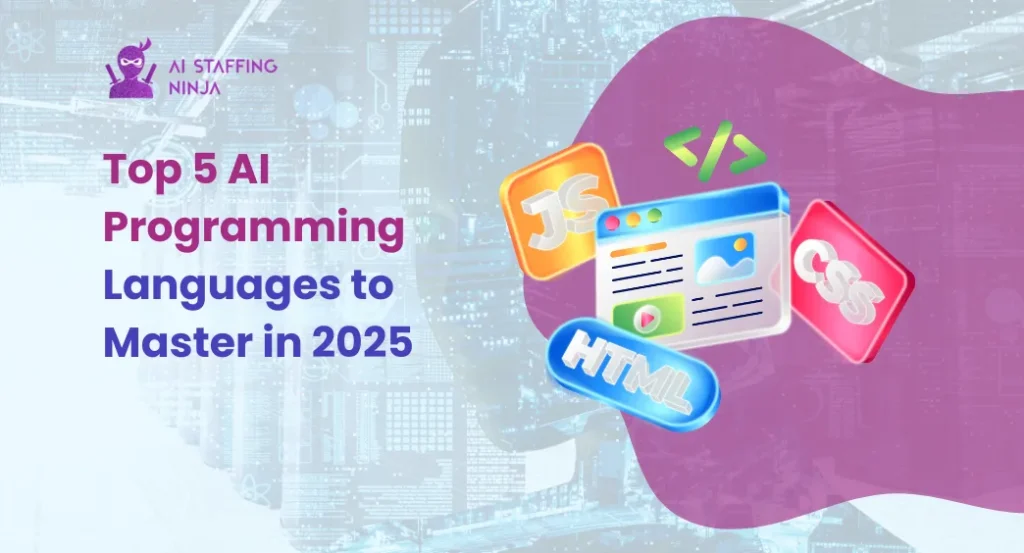
- By : By Staffing Ninja
Top 5 AI Programming Languages in 2025

Everywhere you go, you will hear people talking about artificial intelligence (AI) transforming different sectors to provide cost-reduction, enhanced productivity, and improved decision-making capabilities. The development process of AI involves complex data structures and algorithms implemented using programming languages. The best programming languages for AI are Java, Python, R, C++, and Julia.
However, these languages have different advantages, from ease of use to performance efficiency; the advantages vary. Hence, choosing the right AI programming language becomes important to optimize the AI development process.
Read on to explore the top languages for AI development and choose the perfect language for your next project in AI.
Factors to Consider When Choosing a Programming Language for AI
From Python to C++, there are over 10 AI programming languages in 2025. However, we have focused only on the top five based on their unique features, which make them suitable for certain tasks. Assess your AI development languages for the next project based on the factors below –
Project Need Assessment – Consider the basic features and structure of the program to evaluate the project’s key requirements. While JavaScript is perfect for creating web-based apps, C++ could be ideal for creating robotics due to its low-level hardware integration.
- Consider Learning Curve & Skill Level – The developer’s skill level is important here since the learning curve can vary. Choose the programming language based on your skill level. For instance, Python comes with a flat learning curve because it is beginner-friendly and simple. But with C++, we can expect a steeper learning curve for beginners, as it takes more effort to master.
- Compare Stability & Performance – C++ is perfect for a high-performance task due to its efficient memory management practices and multi-threading ability, whereas Java is better if you are looking for an automated garbage collector in terms of memory management. Compare the execution speed and memory management techniques of programming languages since they can heavily impact stability and performance.
Top Programming Languages for AI
Python
Python is used by leading platforms like PyTorch, TensorFlow, Matplotlib, Scikit-Learn, and NumPy to build powerful AI systems with a blend of advanced features and convenience. It has a user-friendly syntax and a massive ecosystem of frameworks and libraries.
This highly versatile AI development language has several use cases for programming professionals and data scientists. Python’s open-source nature also makes it easy to pair with the large community that contributes to its growth. It covers core deep learning, NLP, high-level neural network APIs, and machine learning, having a high-performance foundation for different AI algorithms, such as neural networks and statistical models.
R
Looking for the go-to AI development language? Then, R is the option for data science applications and AI data analysis. It has built-in functions like lm and glm that allow professionals and developers to engage in statistical modeling. Its Caret and randomForest packages allow AI developers to build, test, and train machine learning models while the hyperparameter tuning feature enables optimization of the ML algorithm performance. R is especially useful for AI projects in finance, research, and healthcare, where data analysis is the most vital aspect.
Java
Java is a commonly used programming language that has various AI frameworks, popular for its scalability, compatibility, and reliability. It is a platform-independent portal, which means Java apps can operate on all computer systems if a Java Virtual Machine (JVM) is installed. The cross-platform portability allows developers to easily build and deploy AI-powered apps across various software and hardware platforms. For example, the Weka machine learning library can collect classification, clustering, and regression algorithms, DeepLearning4j can support neural networks on JVM, while Mallet has NLP capabilities for AI systems. Java is particularly useful for large-scale AI mobile applications, enterprise software, and banking.
Julia
Julia, although a new programming language, is unique in the sense that it is highly compatible with other AI programming languages such as Python, R, and C++. It is designed for numerical computing and high-performance AI development with a user-friendly syntax similar to Python.
Plus, distributed computing and parallelism allow AI apps and platforms to handle heavy computational workloads and massive data sets without any performance degradation. It is particularly helpful in scientific computing and machine learning because of its speed, and being an open source, developers benefit from community control of libraries. Julia offers various tools like MLJ.jl for machine learning and deep learning models, Gadfly.jl for data visualization, and Plots.jl for AI development support.
C++
If a developer wants to deploy an AI-powered model into a low-latency production ecosystem, then C++ is the go-to option. It is a compiled programming language that allows developers to control memory and execute machine learning programs; perfect for AI projects that require massive processing power. All C++ code can be compiled into a standalone executable program.
As for libraries, Caffe2 can be used for deep learning tasks, TensorFlow C++ is perfect for plugging into the machine learning abilities of TensorFlow, while ONNX is the most standard way of exchanging neural networks. C++’s high-performance capabilities make it useful in real-time AI applications, robotics, and gaming. However, it is a little more complex to learn compared to R and Python.
Comparison of AI Programming Languages
The table below shows the AI programming language comparison –
| Language | Strengths | Weakness | Usability | Common AI apps | Examples of AI apps |
| Python | Simple syntax, productive, vast libraries | GIL for threading, Performance issues | High, excellent for beginners and experts | Machine learning, NLP, computer vision | Alexa, Siri, Tesla Autopilot |
| R | Statistical modeling & analysis built-in | Steep learning curve, not a general purpose | Moderate, suitable for data scientists | Data mining, statistical analysis | Google BigQuery ML, IBM Watson Analytics |
| Java | Enterprise-ready, Cross-platform, static typing | Verbose, not AI specialized | Moderate, great for production | NLP, search algorithms, enterprise AI | Cortana, Google Search, Banking APIs |
| Julia | Math capabilities, high performance | Newer language with a smaller ecosystem | Moderate, similar to Python | Numerical analysis, data science | The US Central Bank and the NY Fed use Julia for ML modeling |
| C++ | Fast, efficient hardware control | Complex system programming | Hard, good for advanced developers | Optimized robotics and ML apps | Stock trading, self-driving vehicles |
Final Thoughts
Before you choose the best AI programming language, you first need to understand the use cases of each language and your specific goals. This is because every language serves a different purpose.
For example, Python is safe for intelligent applications powered by AI with frameworks like PyTorch and TensorFlow. But if you’re looking for something specialized with high computational demands, you can consider alternatives such as Java or C++. Therefore, make an informed decision by analyzing your needs and aligning them with a strategic roadmap with the best AI programming languages in 2025.
Choosing the right language is also essential for AI job opportunities, as different roles require different skill sets. Additionally, AI recruitment solutions can help match professionals with the right expertise to industry demands.